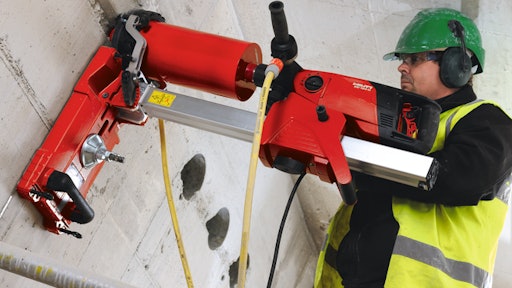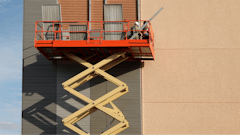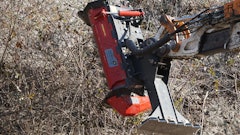
Diamond core drills are primarily rented by mechanical and utility contractors, plumbers and stone masons for drilling holes in walls, ceilings, floors and roads. They can be a small but important part of any project, and premium quality can make the difference between a successful rental and a disappointed customer.
"Contractors generally rent a core drill when they only need to use it for a specific application that is not a major element of the overall job," says Richard Tremain at Husqvarna Construction Products. With that in mind, be sure the models you carry in your rental inventory are up to the challenge.
Selection starts with the basics
Most core drills have an electric motor, but some are hydraulic or air-powered. These tools can be hand-held or rig-mounted, where the motor is secured to a stand with a gear mechanism that allows the operator to move it up and down. The right choice depends on the work to be done.
When selecting the proper core drill, there are a number of things to consider, chief among them is safety. "Our wet electric drills all have built-in GFCIs," notes Scott Saunders at CS Unitec. "And all of our machines have mechanical slip clutches for operator safety."
Kevin Axt with Hilti points out that all Hilti rigs are UL listed as a system (not just a listing on the motor) and come with GFCI cords for greater safety. "Diamond core drills use water and electricity, a potentially dangerous combination," he says. "Third-party testing ensures yet another level of safety for the user and is actually an OSHA requirement."
Also with safety in mind, Saunders recommends a hand-held machine for any holes up to 3 inches, and a drill stand or rig for larger holes. "Make sure the drill has enough power to drill properly," he adds. "Our largest drill has a 24.5-amp motor, one of the most powerful on the market, ensuring power is there when needed for the toughest drilling applications."
Traditionally, rig-mounted units are anchored to the floor before operation, a time-consuming process, particularly when the job requires many holes to be cut. To simplify this process, some manufacturers offer an optional vacuum base that mounts the rig to the floor, explains Axt at Hilti. Setting up the rig this way is faster, since there's no need to drill anchor holes, which can drastically increase efficiency on your customer's job.
Make the right recommendation
According to Tremain, one of the earmarks of quality includes electronic protection for the electric motor to protect it from being overloaded and/or overheated. Several Husqvarna models are equipped with Elgard, which indicates when an overload is approaching, either via an LED or pulsation, depending on the model. "This prevents motor damage and increases the product’s life," he says. "Electronic protection reduces downtime and costly repairs."
Hilti features a unique LED lighting system on its core drills. Axt explains the system not only protects the drill, it actually helps the user become better at operating the equipment. The lights indicate whether operation should go faster or slower for optimum performance. This protects the drill, but it's also a tremendous time saver, Axt says. Because operation is more consistent and efficient, the job gets done faster and with better results, which translates into a more successful rental.
"This is ideal for customers who typically only use this type of tool occasionally and are not experienced on this type of equipment," Axt says. "The LED lights actually train the operator on how to use the tool effectively."
Saunders adds, "Our drills also incorporate LED Lights and leveling bubbles to ensure proper feed pressure and straight drilling."
Another area where quality is apparent is the drill stand. Look for one that is rigid and strong, as it will last longer, provide more support and more accurate drilling, Tremain says. "Stands that feature a roller carriage require less adjustments and maintenance than a slide carriage," he says.
"Look for a drill stand with an appropriately sized anchor slot for the job," Tremain adds. "A longer anchor slot might reduce the amount of holes needed to anchor the stand when drilling multiple holes in close proximity."
Axt points out that Hilti stands are constructed from aluminum, rather than cast iron or steel, to make them lighter and easier to transport. Aluminum stands typically weigh one third of what a steel stand weighs, so the user can get the job done more quickly and efficiently - and with less physical exhaustion.
C.S. Unitec’s drill stands are also constructed of lightweight aluminum for easy transport and assembly, Saunders points out, adding, "They all have a quick change motor block to attach the motor to the rig after the drill stand is set up.”
Hilti also offers motors with a quick-connect chuck which greatly speeds up the process of changing the bit. "With a threaded chuck, changing the bit requires two wrenches. If you don't have those wrenches, there's no changing the bit," Axt explains. "With the quick-connect system, what typically would take one to five minutes can be done in seconds, and with no extra tools."
Another feature which speaks to premium quality is CS Unitec's CS 2000 Water Recycling Vacuum. "When wet core drilling, water is often an issue, either creating a mess or not having it available at the jobsite," Saunders says. "Our recycling vacuum addresses both issues. You start by putting water in the vacuum tank. It's pumped to the core bit to lubricate and cool during operation. The water collection ring then traps the slurry as it is vacuumed back into the tank, which holds the slurry in a bag and allows the water to pass through to be used again and again, in both setup and cleanup, going right back to the bottom line."
ROI is the goal
Core drills offer a high ROI potential because they require minimal maintenance and yet, they offer many opportunities for complementary product sales. Contractors will need core bits, either rented or purchased, and this presents an excellent chance for a rental house to provide additional service to the customer.
Tremain notes another good add-on sale or rented item is an extension cord. "A heavy-gage extension cord is perfect for any drilling application," he says. "If a job location does not have power, the dealer can potentially rent a generator as well. If drilling concrete, water will be needed and this is a good opportunity for renting water supplies such as hoses, tanks or pumps. Some jobs require the slurry to be cleaned up/removed and renting a wet vacuuming system to contain the slurry could also be a good opportunity for the dealer."
Axt says overall, core drill ROI is typically very high. "Average rental rates are about $100 per day plus the fees for renting accessories like core bits and vacuum pumps. Core rigs are normally in service longer than hammer drills and breakers, which increases their ROI."
But like everything else, in the diamond core drilling business, you get what you pay for, Saunders says. "Regarding ROI, an inexpensive drill and core bit will initially save you money because the price is cheap. However, you should look at the total cost, i.e., tools and labor," he says. "Always remember what we are really selling is holes, and the higher-quality machine - with the properly matched core bit - will yield less expensive holes in the long run because you will drill faster and be more productive, thus saving labor and money."





























